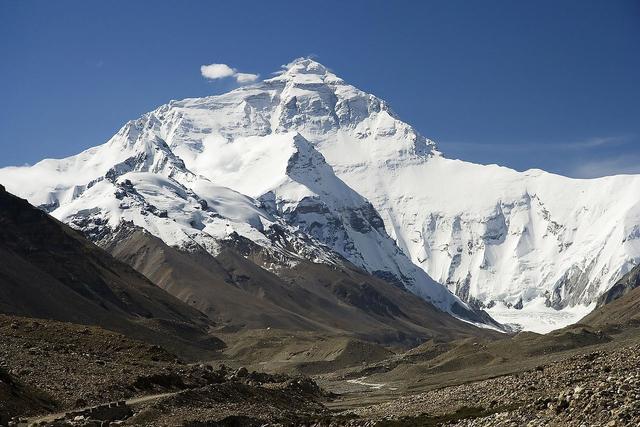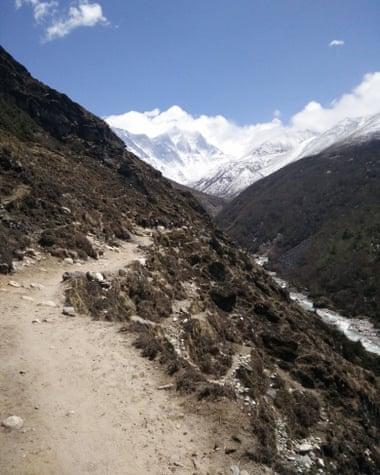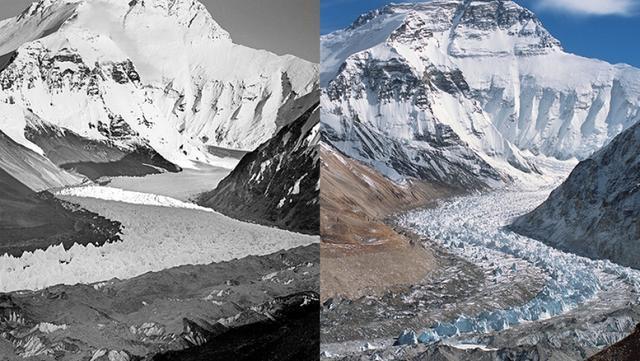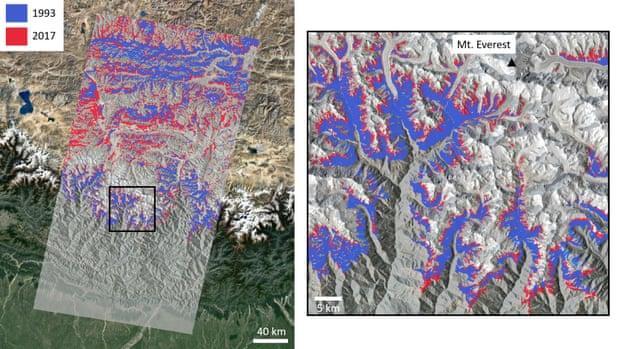Himalayan vegetation is expanding rapidly, is this a good sign or the beginning of a disaster?
The world has a total of 14 peaks with a height of over 8,000 meters, including 10 peaks in the Himalayas and the remaining 4 peaks in the nearby Karakoram mountain range.
The Himalayas are also described as the third pole of the Earth, and even in fact, this mountain range possesses the third largest amount of snow and ice after the North and Antarctica, in addition to this mountain range has the influence the lives of over one billion people in Asia, including China and India.

Recently, a study from the University of Exeter in the UK showed that the vegetation in the Himalayas (Himalayas) is growing continuously at a very fast speed, breaking the snow flow there, at the same time the the snow and white plateau is also gradually turning green.
Maybe on other places on Earth, the fast growing vegetation and greening vast areas is a good sign for nature, but here, this has the opposite meaning. Absolutely not a good sign in the Himalayas.

Previously, the Arctic sea area was also constantly turning green and the phytoplankton in the water also developed very strongly by the melting of ice and snow. However, this is a very bad result due to human activities, so these phenomena are completely not the restoration of nature on Earth.
The reason why plants and phytoplankton can grow and grow in these barren lands is because global warming has caused a glacial melting of snow, providing them with soil to hold on and water for development, this will mean that the ecosystems in these lands will be subject to drastic changes and can lead to the change and reform of a local ecosystem. inherently familiar.

Researchers used NASA satellite images between 1993 and 2018 to measure plant growth in the Himalayas.
The results show that the plant area in the Himalayas is constantly expanding and "wildly" surrounding every corner. Previous studies have also shown that the loss of ice and snow in the Himalayas doubled between 2000 and 2016, and that the entire glacier has lost a quarter of its ice in the past 40 years.

But the researchers also found that in another study conducted in Tibet, many vegetation has a mechanism of cooling itself through the evaporation of leaf surfaces, which may not increase the risk. warming and flooding in the Himalayas.
These contradictory studies mean that we still do not know enough about the effects of global warming and that more research is needed, especially about the "third pole" of the Fruit. The land - the Himalayas, was previously ignored.
Unlike the warming of the North and Antarctic, the melting of snow and ice here will directly affect the livelihoods of 1.4 billion people around the 10 largest rivers in Asia. Therefore, if the ecosystem here is destroyed, it will surely bring unpredictable consequences.
You should read it
- What is Starlink? How does satellite internet work?
- Satellite T135 handles multitasking not well
- Toshiba is new to the Satellite T100-series
- Toshiba introduces Satellite Click, 'bet' on AMD chips
- Toshiba Satellite C600 costs from 8.4 million VND
- Toshiba touch ultrabook and Windows 8 laptop cost $ 600
- How to Use Satellite Internet
- Starlink satellite accused of 'can be deadly'
May be interested
- How to fix 'We can't sign into your account' error on Windows 10
 some windows 10 insider build 20226 users have reported that they were unable to log in to user profile (s) as expected. microsoft now offers a solution for help with this problem.
some windows 10 insider build 20226 users have reported that they were unable to log in to user profile (s) as expected. microsoft now offers a solution for help with this problem. - How does the 'Sign-In with Google' option work?
 when you use sign-in with google to access a website or app, one of the key benefits is that google never shares your password with the website or app.
when you use sign-in with google to access a website or app, one of the key benefits is that google never shares your password with the website or app. - Good time to buy a laptop
 get 50% vat rebate after 1/2 plus new promotions at the beginning of the year, laptops are getting more attractive prices
get 50% vat rebate after 1/2 plus new promotions at the beginning of the year, laptops are getting more attractive prices - 4 Reasons You Should Sign Up for an Audible Membership
 audible makes it easy to stream, download, and listen to audiobooks on your computer, tablet, smartphone, or speaker.
audible makes it easy to stream, download, and listen to audiobooks on your computer, tablet, smartphone, or speaker. - Guidance on registration of cars, granting of license plates via the Internet
 beginning november 15, 2016, the traffic police department implemented a plan to support the conductors to carry out online car registration procedures, reform administrative procedures, minimize travel time of people. .
beginning november 15, 2016, the traffic police department implemented a plan to support the conductors to carry out online car registration procedures, reform administrative procedures, minimize travel time of people. . - How to enable or disable Secure Sign-In on Windows 10
 windows is the operating system most targeted by hackers. therefore, you should reinforce your pc's defense system to keep it safe, even online and offline. this article will show you how to enable or disable secure sign-in on windows 10.
windows is the operating system most targeted by hackers. therefore, you should reinforce your pc's defense system to keep it safe, even online and offline. this article will show you how to enable or disable secure sign-in on windows 10. - 5 animals that can survive a global disaster
 5 animals have a high chance of survival in the event of a global disaster such as an asteroid impact or a serious pandemic outbreak that could wipe out the majority of animal species on earth.
5 animals have a high chance of survival in the event of a global disaster such as an asteroid impact or a serious pandemic outbreak that could wipe out the majority of animal species on earth. - Hackers take advantage of the Katria disaster
 hackers have begun sending e-mail messages titled hot katrina disaster in the us to trick users into accessing dangerous websites.
hackers have begun sending e-mail messages titled hot katrina disaster in the us to trick users into accessing dangerous websites. - Instructions for checking the sign status of iOS firmware
 here are 2 ways to check the sign status of ios firmware that users can choose to use on their ios device.
here are 2 ways to check the sign status of ios firmware that users can choose to use on their ios device. - How to sign a document with GIMP
 why waste paper when you can digitally sign documents? all you need is a picture of your signature, a pdf document you want to sign and gimp!
why waste paper when you can digitally sign documents? all you need is a picture of your signature, a pdf document you want to sign and gimp!










 Because of the Covid-19 epidemic, more than 100 scientists were trapped on icebreakers between the Arctic Ocean
Because of the Covid-19 epidemic, more than 100 scientists were trapped on icebreakers between the Arctic Ocean The little known origin of the N95 respirator
The little known origin of the N95 respirator The reason why the visual effects are always green and 9 filmmakers' secrets that the audience did not know
The reason why the visual effects are always green and 9 filmmakers' secrets that the audience did not know What is a ventilator that every country in the world is racing to have as much as possible?
What is a ventilator that every country in the world is racing to have as much as possible? How did the 5 worst pandemics of human history end?
How did the 5 worst pandemics of human history end? Bizfly Chat: Single closing chatbot will help thousands of businesses survive the Covid-19 season
Bizfly Chat: Single closing chatbot will help thousands of businesses survive the Covid-19 season